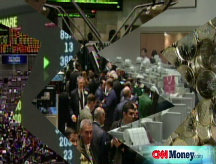Bonds soar on Fed decision
Treasury prices advance after Fed rate cut, consideration of purchasing government debt.
NEW YORK (CNNMoney.com) -- Treasurys rallied Tuesday after the Federal Reserve cut interest rates to historic lows and said it would consider a plan to buy up droves of government bonds.
The Federal Open Market Committee continued its 15-month rate-cutting campaign by slashing its key funds rate to a target of 0% to 0.25% from 1% at the conclusion of its two-day meeting Tuesday afternoon.
The Fed uses its rate-cutting tool in an attempt to boost the economy by lowering the benchmark targeted lending rate between financial institutions. Mired in an ongoing credit crisis, the Fed hopes cutting rates to historic lows will encourage banks to lend, stimulate much-needed job growth and help put the economy on the road to recovery from a now 13-month recession.
Those cuts, which have taken the federal funds rate down 5 to 5.25 percentage points thus far since the rate stood at 5.25% in September 2007, tend to be inflationary, driving down demand for Treasurys with a devalued dollar.
But investors have not needed to worry about inflation recently. The Department of Labor reported Tuesday morning that consumer prices fell by a record 1.7%, with inflation rising just 2% year over year - within the Fed's perceived comfort zone.
"Inflationary pressures have diminished appreciably," the FOMC said in a statement. "In light of the declines in the prices of energy and other commodities and the weaker prospects for economic activity, the Committee expects inflation to moderate further in coming quarters."
Treasurys also soared after the Fed said it plans to look into purchasing large amounts of long-term Treasurys, perhaps as a way of boosting the housing market. Though prices are already at historic highs, they will have more room to grow if the government begins to buy up its own long-term debt.
"Most buyers right now believe that old adage, 'You can't fight the Fed,'" said Kenneth Naehu, managing director of Bel Air Investment Advisors. "Clearly, otherwise, the 10-year and 30-year bonds are not attractive at these low levels."
By purchasing 10-year Treasurys in large volume, the Fed could potentially help to lower mortgage rates for prospective homebuyers. Thirty-year fixed rate mortgages, which have historically moved in step with the 10-year note, currently hover around 5.5% despite 10-year Treasury yields of less than 2.5%. Before the credit crunch, the rates were more typically within a range of 1.5 to 2 percentage points from one another.
"The combination of low home prices and low mortgage rates will make home affordability so much higher," said Bernard Baumohl, chief economist for the Economic Outlook Group. "Ultimately, housing is the epicenter that's holding back the banks and the economy from growing."
Buying up droves of Treasurys may also help encourage banks to lend, as government yields dip even lower into already historic lows. Gaining little return on those investments, banks may be forced to return to their traditional money-maker, issuing loans.
Analysts warn that investors buying up long-term bonds may be taking on considerable risk. With fear the predominant reason for purchasing government bonds, a shift in market sentiment could mean a sudden and massive exit from the Treasury market.
"The market could reverse itself in a heartbeat," said Naehu. "When risky assets become more attractive and the economy is on the mend, it will lead to a violent sell-off. Buying long-term bonds is not for the feint of heart."
Treasurys had been mixed just ahead of the Fed announcement, with all but the 30-year long bond showing declines.
Following the rate-cut announcement, the benchmark 10-year Treasury was up 1 10/32 to 112 6/32 and its yield slipped to 2.36% from 2.51% from late Monday. Bond prices and yields move in opposite directions.
The 30-year rose 2 to 132 8/32 and its yield dipped to 2.86% from 2.95%.
The 2-year note, which is typically most affected by changes to short-term interest rates, was up 5/32 to 101 4/32, while its yield fell to 0.65% from 0.75%.
The yield on the 3-month note rose to 0.03% from 0.02%, and has been hovering around 0% for days. Yields near the zero mark on short-term bills are an indication that investors are completely risk-averse, putting safety at a priority above profit.
Meanwhile, lending rates between banks remained near record low levels. The overnight Libor rate rose to 0.16% from 0.12%, and the 3-month Libor rate fell to 1.85% from 1.87% late Monday, according to Bloomberg.com.
Libor, the London Interbank Offered Rate, is a daily average of what 16 different banks charge other banks to lend money in London, and is used to calculate adjustable-rate mortgages. More than $350 trillion in assets are tied to Libor.
Two market gauges showed confidence edging higher.
The "TED spread" narrowed to 1.81 percentage points from 1.86 percentage points Thursday. The TED spread measures the difference between the 3-month Libor and the 3-month Treasury bill, and is a key indicator of risk. The higher the spread, the more unwilling investors are to take risks.
Another indicator, the Libor-OIS spread, soared to 1.7 percentage points from 1.55 percentage points as the Overnight Index Swap rate plummeted to 0.17% from an opening level of 0.32% Tuesday.
OIS is the actual rate for which the Fed sets its target. The Libor-OIS spread measures how much cash is available for lending between banks, and is used for determining lending rates. The bigger the spread, the less cash is available for lending. ![]()





